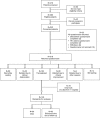Role of Depression and Social Isolation at Time of Waitlisting for Survival 8 Years After Heart Transplantation
- PMID: 29187384
- PMCID: PMC5779021
- DOI: 10.1161/JAHA.117.007016
Role of Depression and Social Isolation at Time of Waitlisting for Survival 8 Years After Heart Transplantation
Abstract
Background: We evaluated depression and social isolation assessed at time of waitlisting as predictors of survival in heart transplant (HTx) recipients.
Methods and results: Between 2005 and 2006, 318 adult HTx candidates were enrolled in the Waiting for a New Heart Study, and 164 received transplantation. Patients were followed until February 2013. Psychosocial characteristics were assessed by questionnaires. Eurotransplant provided medical data at waitlisting, transplantation dates, and donor characteristics; hospitals reported medical data at HTx and date of death after HTx. During a median follow-up of 70 months (<1-93 months post-HTx), 56 (38%) of 148 transplanted patients with complete data died. Depression scores were unrelated to social isolation, and neither correlated with disease severity. Higher depression scores increased the risk of dying (hazard ratio=1.07, 95% confidence interval, 1.01, 1.15, P=0.032), which was moderated by social isolation scores (significant interaction term; hazard ratio = 0.985, 95% confidence interval, 0.973, 0.998; P=0.022). These findings were maintained in multivariate models controlling for covariates (P values 0.020-0.039). Actuarial 1-year/5-year survival was best for patients with low depression who were not socially isolated at waitlisting (86% after 1 year, 79% after 5 years). Survival of those who were either depressed, or socially isolated or both, was lower, especially 5 years posttransplant (56%, 60%, and 62%, respectively).
Conclusions: Low depression in conjunction with social integration at time of waitlisting is related to enhanced chances for survival after HTx. Both factors should be considered for inclusion in standardized assessments and interventions for HTx candidates.
Keywords: depression; heart failure; psychology and behavior; social isolation, social contacts; survival analysis; transplantation.
© 2017 The Authors. Published on behalf of the American Heart Association, Inc., by Wiley.
Figures


Similar articles
-
Social isolation and depression predict 12-month outcomes in the "waiting for a new heart study".J Heart Lung Transplant. 2010 Mar;29(3):247-54. doi: 10.1016/j.healun.2009.07.018. Epub 2009 Oct 4. J Heart Lung Transplant. 2010. PMID: 19804987
-
Medical and psychosocial predictors of mechanical circulatory support device implantation and competing outcomes in the Waiting for a New Heart Study.J Heart Lung Transplant. 2012 Jan;31(1):16-26. doi: 10.1016/j.healun.2011.07.018. Epub 2011 Oct 1. J Heart Lung Transplant. 2012. PMID: 21959123
-
Composite risk scores and depression as predictors of competing waiting-list outcomes: the Waiting for a New Heart Study.Transpl Int. 2010 Dec;23(12):1223-32. doi: 10.1111/j.1432-2277.2010.01133.x. Transpl Int. 2010. PMID: 20630044
-
Psychosocial and behavioural factors in heart transplant candidates--an overview.Transpl Int. 2007 Nov;20(11):909-20. doi: 10.1111/j.1432-2277.2007.00503.x. Epub 2007 Jun 3. Transpl Int. 2007. PMID: 17543024 Review.
-
Cardiac transplantation is still the method of choice in the treatment of patients with severe heart failure.Cardiol J. 2009;16(6):493-9. Cardiol J. 2009. PMID: 19950084 Review.
Cited by
-
Prevention and Rehabilitation After Heart Transplantation: A Clinical Consensus Statement of the European Association of Preventive Cardiology, Heart Failure Association of the ESC, and the European Cardio Thoracic Transplant Association, a Section of ESOT.Transpl Int. 2024 Jun 19;37:13191. doi: 10.3389/ti.2024.13191. eCollection 2024. Transpl Int. 2024. PMID: 39015154 Free PMC article.
-
Sex Differences in Recovery and Device Replacement After Left Ventricular Assist Device Implantation as Destination Therapy.J Am Heart Assoc. 2022 Mar;11(5):e023294. doi: 10.1161/JAHA.121.023294. Epub 2022 Feb 22. J Am Heart Assoc. 2022. PMID: 35191318 Free PMC article.
-
Social Isolation and Implementation of Advanced Care Planning Among Hospitalized Patients With Heart Failure.J Am Heart Assoc. 2022 Nov;11(21):e026645. doi: 10.1161/JAHA.122.026645. Epub 2022 Oct 27. J Am Heart Assoc. 2022. PMID: 36300657 Free PMC article.
-
Association of social isolation and depressive symptoms with workplace productivity loss in a multi-ethnic Asian study.Sci Rep. 2024 Sep 27;14(1):22145. doi: 10.1038/s41598-024-73272-4. Sci Rep. 2024. PMID: 39333633 Free PMC article.
-
Renal Function in Patients with or without a Left Ventricular Assist Device Implant During Listing for a Heart Transplant.Ann Transplant. 2020 Nov 10;25:e925653. doi: 10.12659/AOT.925653. Ann Transplant. 2020. PMID: 33168796 Free PMC article.
References
-
- Lund LH, Edwards LB, Kucheryavaya AY, Benden C, Christie JD, Dipchand AI, Dobbels F, Goldfarb SB, Lewey BJ, Meiser B, Yusen RD, Stehlik J. The registry of the International Society for Heart and Lung Transplantation: thirty‐first official adult heart transplant report–2014; focus theme: retransplantation. J Heart Lung Transplant. 2014;33:996–1008. - PubMed
-
- International Society for Heart and Lung Transplantation . Quarterly Data Report. 2016. Available at: https://www.ishlt.org/registries/quarterlyDataReportResults.asp?organ=HR.... Accessed January 10, 2017.
-
- Smits JM, De Pauw M, de Vries E, Rahmel A, Meiser B, Laufer G, Zuckermann A. Donor scoring system for heart transplantation and the impact on patient survival. J Heart Lung Transplant. 2012;31:387–397. - PubMed
Publication types
MeSH terms
LinkOut - more resources
Full Text Sources
Other Literature Sources
Medical

